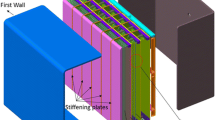Abstract
An upgraded form of China fusion engineering test reactor (CFETR) was investigated for the safety performance. In the current study, modification of the designs were presented with relative tolerance. The steady state were calculated for the new design using Relap5 code. Two accidents were simulated i.e., in-vessel and In-box loss of coolant accident. These accidents were simulated in helium cooled ceramic blanket (HCCB) system for the purpose to investigate the safety measures of the CFETR. It is utmost important to ensure the safety performance of the reactor. In this research, sudden break at blanket system was assumed and calculated different parameters including temperature, pressure and coolant fluxes to observe the differences in pattern during the accident under limited time domain. The research is very important because the design of HCCB is new and there is a need to conduct steady state and transient state of the reactor in order to make sure and authenticate the design and to safer the reactor.
















Similar content being viewed by others
References
Y.T. Song, W.Y. Wu, S.J. Du et al., Tokamak Engineering Mechanics (Springer, Berlin, 2014)
M. Keilhacker, M.L. Watkins, JET, team. D-T experiments in the JET tokamak. J. Nucl. Mater. 266–269, 1–13 (1999)
S. Ishida, P. Barabaschi, Y. Kamada, The JT-60SA team. Status and prospect of the JT-60SA project. Fusion Eng. Des. 85, 2070–2079 (2010)
J.S. Bak, H.L. Yang, Y.K. Oh et al., Current status of the KSTAR construction. Cryogenics 47, 356–363 (2007)
M. Lei et al., Process on CFETR HCCB blanket design, ASIPP & PPPL Blanket Integration Design Team Meeting, November 2015. China
I. Ricapito et al., The ancillary systems of the European test blanket modules: configuration and integration in TIER. Fusion Eng. Des. 85, 1154–1161 (2010)
L.V. Boccaccini et al., The EU TBM systems: design and development programme. Fusion Eng. Des. 84, 333–337 (2009)
J. Xuezhou, R. Meyder, Thermal-hydraulic system study of the helium cooled pebble bed (HCPB), blanket module (TBM) for ITER using system Code RELAP5. Plasma Sci. Technol 7(2), 2753 (2005)
L.V. Boccaccini, R. Meyder, X. Jin, Analysis of three LOCAs for the European HCPB test blanket syste. Fusion Eng. Des. 82, 2335–2340 (2007)
Y. Zhang, T. Peng, Modeling TBM components by using Relap5 code. ICONE-21, Paper ID:16304, July 29–August 02, 2013, China
M.Y. Ahn et al., Preliminary safety analysis of korean helium cooled solid breeder test blanket module. Fusion Eng. Des. 83, 1753–1758 (2008)
E. Popov, G.L. Yoder, S.H. Kim, Relap5 model of the first wall/blanket primary heat transfer system, Doc no. US ITER 12101-TD0001-R00. 2010
T. Ihli, T.K. Basu, L.M. Giancarli et al., Review of blanket designs for advanced fusion reactors. Fusion Eng. Des. 83, 912–919 (2008)
RELAP5/MOD3.3 Code Manual Volume., Code Structure, System Models, and Solution Methods, vol. I (Nuclear Safety Analysis Division, Idaho, 2001)
RELAP5/MOD3.3 Code Manual, User’s Guide and Input Requirements, vol. II (Nuclear Safety Analysis Division, Idaho, 2001)
M.J. Wang et al., Thermal hydraulic and stress coupling analysis for AP1000 Pressurized Thermal Shock (PTS) study under SBLOCA scenario. Appl. Thermal Eng. 122, 158–170 (2017)
J.J. Serrano-Aguilera, L. Valenzuela, L. Parras, Thermal hydraulic RELAP5 model for a solar direct steam generation system based on parabolic trough collectors operating in once-through mode. Energy 133, 796–807 (2017)
L. Shuzhou et al., Thermal hydraulic and stress coupling analysis for AP1000 Pressurized Thermal Shock (PTS) study under SBLOCA scenario. Appl. Therm. Eng. 117, 443–451 (2017)
S.U.D. Khan et al., Thermal hydraulic analysis of CFETR during thermal quenching by comparative approach of Relap5 and theatre code. Modern Phys. Lett. B 30(30), 1650357 (2016)
A. Kaliatka, M. Valincius, Modeling of pipe break accident in a district heating system using RELAP5 computer code. Energy 44, 813–819 (2012)
X.M. Cheng et al., Thermal hydraulic responses of the primary heat transfer system of the WCCB blanket to accident cases for CFETR. Fusion Eng. Des. 121, 50–59 (2017)
Q. Lian et al., Preliminary safety assessment on two LOCAs under ITER-like condition for the optimized CFETR helium cooled solid breeder blanket. Fusion Eng. Des. 121, 235–244 (2017)
Acknowledgements
The authors would like to sincerely appreciate the Research Center, College of Engineering at King Saud University for its funding of this research.
Author information
Authors and Affiliations
Corresponding author
Rights and permissions
About this article
Cite this article
Khan, S.UD., Wang, J., Song, Y. et al. Steady State and Transient Analysis of Novel Design Helium Cooled Ceramic Blanket (HCCB) System of China Fusion Engineering Test Reactor (CFETR). J Fusion Energ 37, 308–316 (2018). https://doi.org/10.1007/s10894-018-0191-0
Published:
Issue Date:
DOI: https://doi.org/10.1007/s10894-018-0191-0




